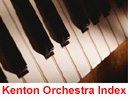|
|
|
|
Even avid Kentonphiles can't agree on just what constitutes the Kenton trombone "Sound." While almost all tend to agree that the "Sound" was (and continues to be) the heart of the band, there is little accord beyond that. Some look to the dissonance of the bands' first fifteen years, while others remember the relative consonance of the later years. Both are right. That's because there were two distinct and separate Stan Kenton trombone section "Sounds."
Why the disparity?
That's
easy.
You just have to keep in mind that the vision Stan Kenton had for his band wasn't always understood, and many times not shared, by the band members. In one notable instance, which I'll get to later, it wasn't even understood by Stan himself. In 1946 there were no "progressive" big jazz bands to speak of. Kenton's assault on traditional big band jazz was a lonely one; one fraught with a particular kind of personnel problem. There were hundreds of excellent players to choose from when a replacement was needed, but virtually all of them came from dance bands. It wasn't the simple matter of just "plugging in" your new lead trombone player, like with other bands. Joining Kenton took some intense indoctrination. Stylistically, the lack of vibrato and wide dynamic range (both softer and louder) spelled the early demise for many otherwise excellent players. Add to that the "Out There" music and you can see the magnitude of the problem of keeping the Kenton Band fully staffed. And let's face it: many players joined the band simply because they needed a job, and the Kenton Band offered some long-term possibilities. They didn't give a whit about the music, just the paycheck. And it showed. Some of the dissonance in those early bands weren't entirely from the pens of the arrangers. Some of it came from inattentive players "putting in their time" waiting for an offer from a band more suited to their personal musical tastes. In fact, quite a few players who are venerated by Kenton fans because of their career accomplishments fit this description. More plainly said, being a famous trombone player didn't necessarily make one a "Kenton" trombone player.
Bob
Fitzpatrick then added some touches of his own; further defining the
Fitz also changed the dynamic (or volume) balance of the trombone section. In dance bands the lead (or first) trombone always played quite a bit louder than the rest of the section. This was done to carry the melody and provide a simple harmony so dancers would have something steady to keep them on the beat. But in a jazz situation - Kenton in particular - this was neither needed nor wanted. Therefore, as a regular practice, Bob had the other trombones play at the same volume he did. And because of the nature of some of the writing, he often asked the bass trombones or tuba to play louder than him. (Writers note: This was a dangerous thing to do. A famous orchestra conductor once said: "Never look at the trombones. It only encourages them." Double that for bass trombones. Theirs' is a spice that must be used sparingly. Fitzpatrick, and Dick Shearer after him, kept things well in check.). Speaking of Dick Shearer . . .
While his fine-tuning of the internal dynamic balance of the trombone section was a major step, Dickus also added the finishing touch - the final ingredient - that completed the Kenton trombone "Sound" we all know and love; and single-handedly changed for all time the way the music of Stan Kenton is played. What was this Herculean task? He played softer.
Dick expanded the dynamic range of the band by adding the dynamic level pianissimo (extremely soft); first to the trombone section, and then to the band itself. The obvious example is Dee Barton's arrangement of "Rainy Day." When I first heard it played in 1968, the opening trombone soli was played mezzo-piano (medium soft). That was a shock. Kenton playing soft. Call the nut-house. We're sending over 19 new "guests." But as the arrangement continued, gathering itself into a true "Mannheim Steamroller," the fortissimo climax two-thirds of the way through was breathtaking. But Dick hadn't forced the issue yet. The next time I heard it, 1972, the opening soli was played at a true classical pianissimo (as soft as possible). This time, the fortissimo climax emotionally shook me. When I rejoined the band in 1974, the opening soli was performed even softer yet (Forget musical designations. The trombones played it hardly louder than a thought). It took me over two weeks before I could find a way to play it with the rest of the section. I was sure I was going to be fired because I couldn't play this one song correctly. The fortissimo climax was now perceived by the audience as pure and utter thunder.
So
there you have it. From enthusiastic, adventurous trombone players
trying desperately to unlearn dance band techniques in order to please
this new skinny leader with a vision, through bored uncaring players
who just wanted to get through the tour, to Kai Winding, Bob
Fitzpatrick, and Dick Shearer. I've left out some minor events along
the way, but in essence this is how the "Stan Kenton Trombone Sound"
came into being. |
|
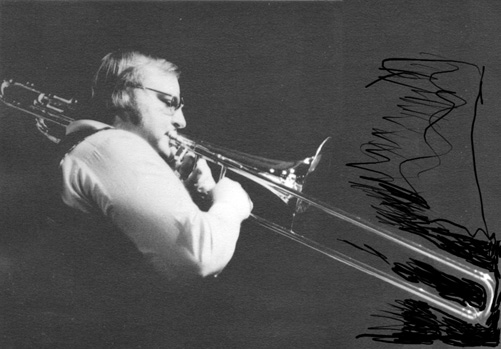

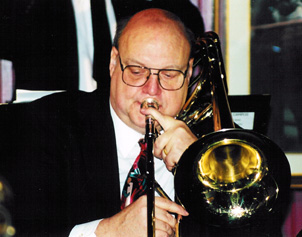
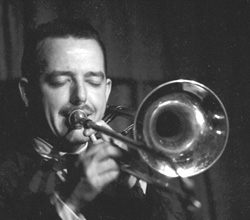 Which
leads me to that "notable instance" I spoke of earlier. And I must tell
you that this is a story Stan told on himself many times. He felt that
the Kenton trombone "Sound" should be credited to (or blamed on,
depending on what era of Kenton music you enjoy the most) Kai Winding.
Kai was one of the first "BeBop" trombone players to join the trombone
section. And his musical sensibilities extended even to his ensemble
playing. As Stan put it (And this isn't a direct quote, I'm
paraphrasing. So sue me.):
Which
leads me to that "notable instance" I spoke of earlier. And I must tell
you that this is a story Stan told on himself many times. He felt that
the Kenton trombone "Sound" should be credited to (or blamed on,
depending on what era of Kenton music you enjoy the most) Kai Winding.
Kai was one of the first "BeBop" trombone players to join the trombone
section. And his musical sensibilities extended even to his ensemble
playing. As Stan put it (And this isn't a direct quote, I'm
paraphrasing. So sue me.): 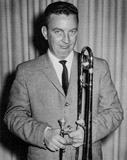 Kenton trombone "Sound." One of his most profound additions was what's
called a "Breath Attack." Using this technique in the context of a song
- virtually always a ballad - repeated notes were not tongued in the
traditional manner, but just "pushed along" with an added surge of air.
The best example of this I can think of occurs in "I'm Glad There Is
You" from the Romantic Approach album. In the beginning trombone soli
(corresponding to the words "In this world"), the first note is tongued
in a traditional manner, but the second and third notes are played with
a breath attack. It's a very effective musical statement - unique to
the Kenton Band. It came from the fertile mind of Bob Fitzpatrick.
Kenton trombone "Sound." One of his most profound additions was what's
called a "Breath Attack." Using this technique in the context of a song
- virtually always a ballad - repeated notes were not tongued in the
traditional manner, but just "pushed along" with an added surge of air.
The best example of this I can think of occurs in "I'm Glad There Is
You" from the Romantic Approach album. In the beginning trombone soli
(corresponding to the words "In this world"), the first note is tongued
in a traditional manner, but the second and third notes are played with
a breath attack. It's a very effective musical statement - unique to
the Kenton Band. It came from the fertile mind of Bob Fitzpatrick.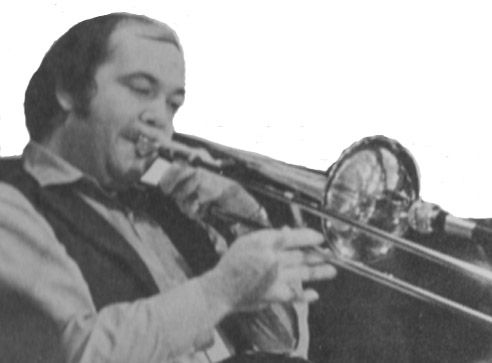 He's
sometimes maligned as a caricature of all who preceded him, but that's
a very unfair assessment. Yes, It was Dick Shearer who pushed the
envelope on the long BOPP! instigated by Kai Winding years before. He
also utilized Bob Fitzpatrick's breath attacks in new and different
situations (listen to Hank Levy's "Blues Betwixt and Between" for a
good example of how he used this device in more up-tempo tunes). And he
certainly added to the dynamic balance of the trombone section. He
demanded that the other four members of the section play slightly louder
than him all the time! Why? Because he knew that the highest note in
the chord would always be heard - no matter what.
He's
sometimes maligned as a caricature of all who preceded him, but that's
a very unfair assessment. Yes, It was Dick Shearer who pushed the
envelope on the long BOPP! instigated by Kai Winding years before. He
also utilized Bob Fitzpatrick's breath attacks in new and different
situations (listen to Hank Levy's "Blues Betwixt and Between" for a
good example of how he used this device in more up-tempo tunes). And he
certainly added to the dynamic balance of the trombone section. He
demanded that the other four members of the section play slightly louder
than him all the time! Why? Because he knew that the highest note in
the chord would always be heard - no matter what.  Throughout
its history, the Stan Kenton Bands were always known for
their raw, naked, overpowering LOUDNESS! Omigod! The trumpet players
all had hernias. The drummers played with cut down baseball bats.
Everybody was deaf for hours afterward. Well, that's a little
exaggerated, but not much. In truth, the band generally played between
mezzo-forte (medium loud) and fortissisisimo (louder than hell). And
Dick Shearer ruined it all by playing softer. NOT!
Throughout
its history, the Stan Kenton Bands were always known for
their raw, naked, overpowering LOUDNESS! Omigod! The trumpet players
all had hernias. The drummers played with cut down baseball bats.
Everybody was deaf for hours afterward. Well, that's a little
exaggerated, but not much. In truth, the band generally played between
mezzo-forte (medium loud) and fortissisisimo (louder than hell). And
Dick Shearer ruined it all by playing softer. NOT!